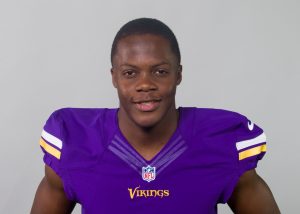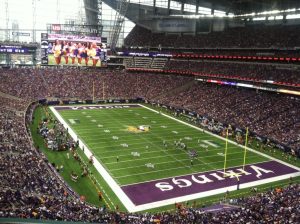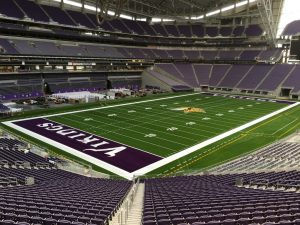Sportswriters are allowed to be homers—and infrequently amateur comedians. Yesterday was a rare opportunity to take a swing at both.
Experiencing U.S. Bank Stadium for the first time was a crash course in civic pride. The new home of the Vikings is an extraordinary structure of glass and steel that’s going to be drawing regional and national attention to Minneapolis for years. Even grade schoolers know the outcomes of NFL exhibition games are meaningless, but yesterday’s Vikings-Chargers preseason event made history. The Vikings played their first ever game in a space-age facility that makes their previous homes look primitive.

Let’s start at the beginning of my day Sunday. It was a 25-minute cruise from Eden Prairie to downtown. All went well except for the driver on 35W who signaled left for about a minute, then turned right. Fooled me. It was kind of like Teddy Bridgewater “breaking ankles” on the Chargers when he made that long first half run.
My parking plan went haywire when I discovered the lot I used three years ago for games at the Metrodome no longer existed. I didn’t investigate but the guess is the property is dedicated to new housing on the east side of downtown.
At 10:30 a.m. there was a lot of street parking within eight blocks or so of the stadium. I pulled into a spot, but then changed my mind. A wine-and-cheese foursome standing near their car sneered at me when I asked about the cost for meter parking.
“Twenty-five dollars,” said a lady who was too important to make eye contact with me.
I drove to a surface parking lot on Ninth Street and Third Avenue. This location turned out to be a “nice bonus” for my physical conditioning. Instead of the expected 14-block round trip walk I planned before leaving home, I logged out at closer to 22 blocks by day’s end. I paid a $15 parking fee for the privilege.
On my walk to the stadium I didn’t encounter any of the reported $50 and $75 parking charges but that wouldn’t be a surprise. I did talk with a man on the street selling game tickets who was asking the face value of $180 each for the lower level seats. There was that kind of demand for exhibition game tickets yesterday—with the Vikings attracting a record crowd for a home preseason game.
As I walked to the new stadium I remembered attending the first Vikings regular season game ever at five-year-old Metropolitan Stadium. The 1961 NFL expansion franchise Vikings were a curiosity back then. They were hardly part of the city and state’s DNA as documented by the 32,236 fans who attended the game and saw the Vikings upset the legendary Chicago Bears 37-13. Vikings fans don’t take that crowd count with too much shame. The next week the Purple travelled to Dallas where the announced attendance was 12,992.
Metropolitan Stadium was a baseball facility that out of necessity doubled as a football venue. Even the best football seats were so far from the field that binoculars were an option. The Bloomington stadium did have its charm, though, including early days when customers parking east of the building walked through corn fields to arrive at the gates.
The Metrodome was a football facility that doubled as the baseball home of the Twins. When the Metrodome first opened, everyone knew it was a low-budget facility but there was excitement about it being one of the few domed stadiums in the country. The Metrodome infused the Twins and Vikings with new revenues, and maybe saved one or both franchises from relocating. Its Teflon-coated fiberglass roof guaranteed fans that games would be played regardless of the weather, and the noise inside provided a rousing home-field advantage in the World Series for the Twins and in big games for the Gophers and Vikings. With its air-supported roof, the dome even produced cheap thrills for patrons when wind gusts shot them through the exit doors and out toward the street.
The Purple Palace that opened to Viking fans yesterday is on the burial site of the Metrodome. It is not your grandfather’s Met, or mother’s Mall of America Field. The facility is imposing on the outside—looking like a giant Norseman’s ship navigating its way to the new world. Inside what fans will care about most is how well they can see the action on the field and what their total stadium experience will be.

Looking west from the press box the view is a knockout. The press box is located on the stadium’s third level with views of the glass-enclosed west end and downtown. That glass and the plastic covering much of the roof made sunglasses welcome yesterday and delivered on the promise of an outdoor feel in an indoor stadium.
How impressive is that to be in a temperature-controlled covered stadium looking at a sun-splashed field?
The west and east ends of the stadium have King Kong size video screens providing vivid looks at what’s happening on the field. With over 66,000 seats not every customer can be on top of the action, but U.S. Bank Stadium seats are pitched high to provide proximity to the field. Some of the seats are 41 feet from the front row to the turf. By contrast, you might do a little vertigo with $59 nosebleed seats, but that’s to be expected in a large venue.
Fans will meander around the inside and outside of the stadium. They can walk the concourses, see views of the field and choose from an imaginative and varied number of food and beverage options. A must-stop for many customers is the Vikings Voyage located in the northwest corner of the stadium. The free admission area offers experiences like catching passes while wearing a virtual reality Vikings helmet and hitting a tackling sled measuring impact force.
Fans can use the new Vikings app on their smartphones to enhance the stadium experience with all kinds of information. There are 1,300 Wi-Fi access points, 2,000 HD TV’s and 30,000 square feet of video displays inside and outside of the stadium. More than $60 million was spent on technology throughout the stadium.
The building has seven levels and includes 430 concession points of sale, 37 escalators, 11 elevators, 979 restrooms, 350 pieces of commissioned art, 250 photographs—and the list of amenities, things, goes on and on.
Yesterday fans roared their approval of the new stadium and the Vikings…kind of like a bunch of excited kids set to make their first blow on the Gjallarhorn. There were purple-clad fans everywhere and at kickoff the team and building were greeted with a standing ovation. Decibel levels were attention getting, and this was just an exhibition game. Wait until the Packers come west to Minneapolis and visit the Wilf palace for the first regular season game September 18!
I’m sure there were some grouchy and even disappointed fans yesterday–always are. Maybe they thought it took too long to move through security into the building. Some customers had come expecting the five massive pivoting doors to be open but they were closed on a sultry day to maintain a 72 degree inside temperature. Reportedly lines were long at some concession stands, and I won’t try to tackle the subject of whether there were any bathroom issues.
But dang, the Vikings won, the place was packed, and the Vikings have a magnificent home that can work its way through a lot of opening day snags. What ruled yesterday were smiles galore and thumbs up from fans.
Even the often cynical media is mostly positive about the stadium. From Forbes to Sports Headliners, the reviews have been glowing.
Perhaps the best line of the day was from the fan who held up this sign: “You should be here.”
Comments Welcome





